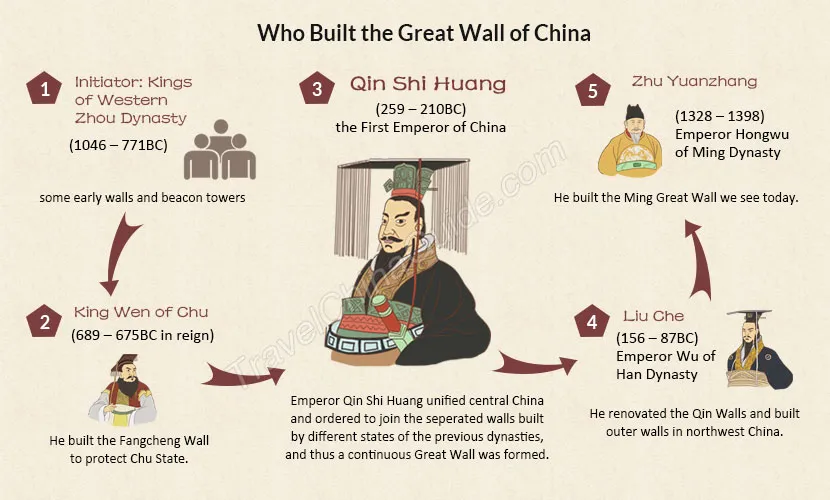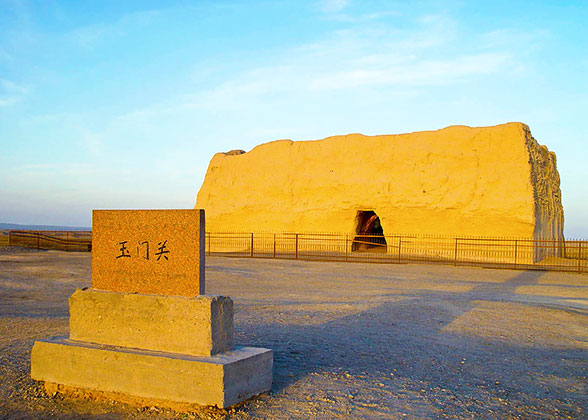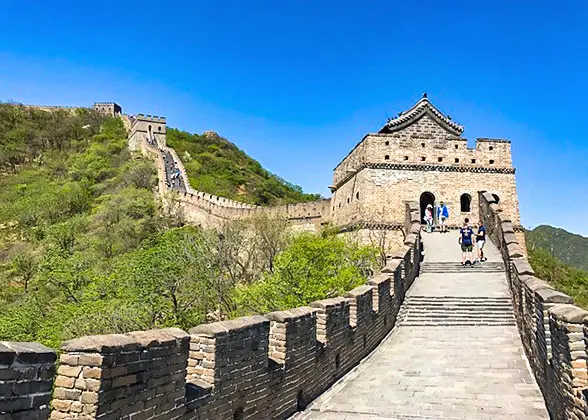Top 8 Great Wall of China Events in History
1. The History of the Great Wall Started with the Chu State ‘Square Wall’ in the 7th Century BC
The initial construction of the Great Wall is one of the most important Great Wall of China events. In 7th Century BC during the Spring and Autumn Period (770 - 476 BC), Chu State built a defensive wall to prevent attacking from the neighboring Zheng State and Qin State. The defensive wall was not what we see today, a long wall with dense watch towers. Instead, it was a square city wall built on the mountain ridges, especially on strategically important places. Due to its square layout, it is called ‘Square Wall’ or ‘Fang Cheng’ in Chinese. Although constructed of rough stones and much clumsier, more rugged, simple and primitive compared to the later sections, it still had a strong defense capability. Other states also began to build this kind of defensive walls in the following hundreds of years to defend against enemies. In a word, the Chu State Square Wall marks the start of the Great Wall construction and you can still find some dilapidated walls in today’s Nanyang, Pingdingshan, Zumadian and Xinyang Cities of Henan Province.
![]() Read more: Great Wall of Chu State
Read more: Great Wall of Chu State
2. Emperor Qin Shi Huang Connected the Separate Walls to Form a Connective Long Wall.
Referred to the Great Wall of China events, we cannot miss an important person, Emperor Qin Shi Huang (259 BC - 210 BC). He is the first emperor in China’s history who unified all the states of ancient China for the first time. After unifying the whole country, he ordered to dismantle several original defensive walls among those states and connected the remains to defend against the northern nomadic Huns. The new connective long wall, Great Wall, also known as the famous “Wan-li Chang Cheng”, was titled one of the “7 Wonders in the Medieval World”.
![]() Read more: Qin Dynasty Great Wall
Read more: Qin Dynasty Great Wall
 |
3. The Great Wall Extended Westward for Resisting Huns in the Western Han Dynasty (202 BC - 9 AD)
 |
| Yumenguan Pass Relics |
In the early stage of the Western Han Dynasty, the Qin Great Wall in bad repair was still helpful to protect China from attacking. After the heroic Wei Qing and Huo Qubing beat the Huns and kicked them out of the Hexi Corridor, more Chinese people had migrated to Hexi. For the border security, the Emperor Wu commanded to build a new section of Great Wall in today’s Gansu area and dispatched garrison troops. As the Han Great Wall was most constructed on the prairie and desert, people built it of losses, gavels and sands with tamarisk and reed as inner fillings. The Han Great Wall not only played an important role in resisting Huns but also laid a historical ground for opening the Silk Road. The Yumen Pass in Dunhuang City was the best-preserved Han Great Wall relic.
![]() Read more about:
Read more about:
Wei Qing and Huo Qubing Beat Back the Huns
4. Genghis Khan Breached Great Wall in the 13th Century
As an important barrier of the ancient China, the Great Wall helped to withstand invaders for heaps of times. However, the founder of the Mongol Empire, Genghis Khan was the first and only one who breached the Great Wall in a long history, which is a rare Great Wall of China event. Several reasons had contributed to the event. First, in the 13th century, most of the Great Wall sections were for long years out of repair and the defense capability had been weakened greatly. Second, the core defensive force of Great wall mainly based on the passes where stationed a lot of troops. The Mongolian army had concentrated the force to breach key passes like Tongguan, Juyongguan and Wusha Fortress. The last but not least, there was a great disparity in military forces between the two armies.
![]() Read more about How did Genghis Khan breach China Great Wall?
Read more about How did Genghis Khan breach China Great Wall?
5. Massive Great Wall Construction in the Ming Dynasty (1368-1644)
 |
| Mutianyu Built in Ming Dynasty |
In the Ming Dynasty, the emperors decided to set up the most solid defensive line in northern China by building the Great Wall. In the early stage (1638-1447), the Ming Dynasty had a strong military force and the construction and reparation of the Great Wall mainly focused on the key passes from Beijing to Datong, Shanxi Province. However, in the middle period (1448-1566), the empire was not so strong and the border was often attacked by northern nomadic groups like Tartar, which forced Ming emperors to strengthen the construction of the Great Wall constantly within a hundred of years. The massive Ming Great Wall started east from Hushan, Liaoning Province, connected with the ancient Qin Great Wall and went west to Jayuguan Pass, stretching around 8,851.8 km (5,500 mi). Most sections we see today were built then, such as Badaling, Mutianyu, and Jinshanling.
![]() Read more: Ming Dynasty Great Wall
Read more: Ming Dynasty Great Wall
6. Qing Armies Entered Central Plain via Shanhaiguan Pass in 1644
The Ming Dynasty fell because of internal corruption and serious natural disasters, which also caused massive peasant uprising and aggression of the Qing Armies who originally garrisoned outside the Great Wall. The two forces struggled to take over the country. In 1644, Li Zicheng, the leader of the peasant army first occupied then capital Beijing but a senior general of the Ming Dynasty, Wu Sangui led his army to retreat to Shanhaiguan Pass and refused to surrender to Li Zicheng. At the same time, Qing Armies were marching to the pass. General Wu finally chose to surrender to the Qing Armies and opened the Shanhaiguan Pass to let the Qing Armies in. They defeated the peasant army led by Li Zicheng together and Chinese history entered a new chapter as the Qing Dynasty (1644 - 1911) came to power.
![]() Read more: The War of Shanhaiguan Great Wall
Read more: The War of Shanhaiguan Great Wall
7. The Final Construction of the Great Wall in 1878
In the whole Qing Dynasty, the emperors didn’t pay much attention to the construction of the Great Wall, just ordered to repair some key passes like Shanhaiguan. However, things changed when it came to the 19th century. The Qing Dynasty’s rule was threatened when western powers appeared. After the Second Opium War (1856), in order to make compensation for Britain, the Qing government collected a great number of money from the common people. People had nothing to depend on for their living and a new round of peasant uprising started. For suppressing the rebellions, the Qing government commanded to build the Great Wall until 1878 in today’s Shanxi area. This is also the last construction of the Great Wall. However, the Qing Great Wall was only built in a hurry for a temporary purpose to withstand the peasant armies, so it is hard to parallel with the solid Ming Great Wall no matter in defense capability or appearance.
![]() Read more: Qing Dynasty Great Wall
Read more: Qing Dynasty Great Wall